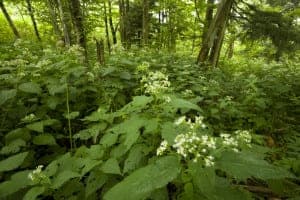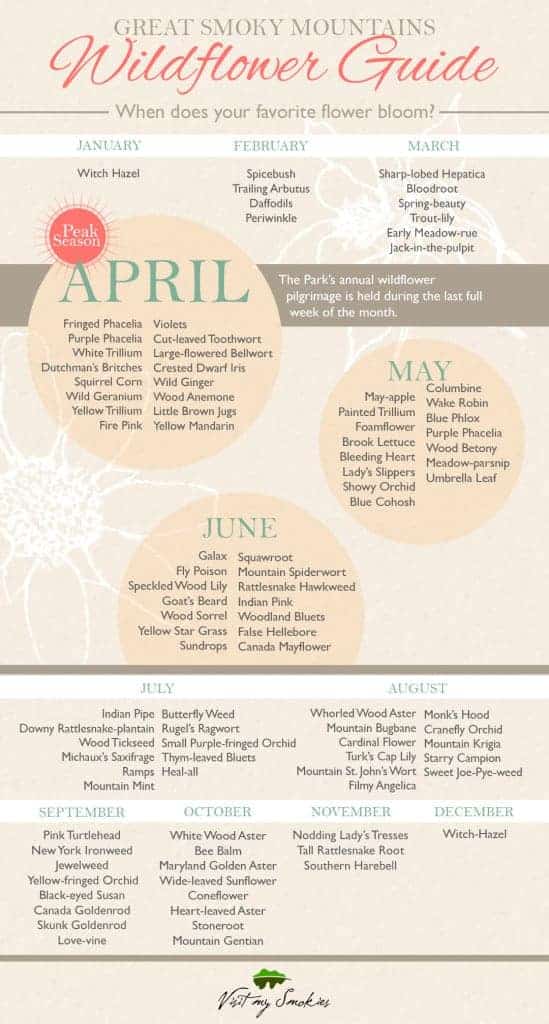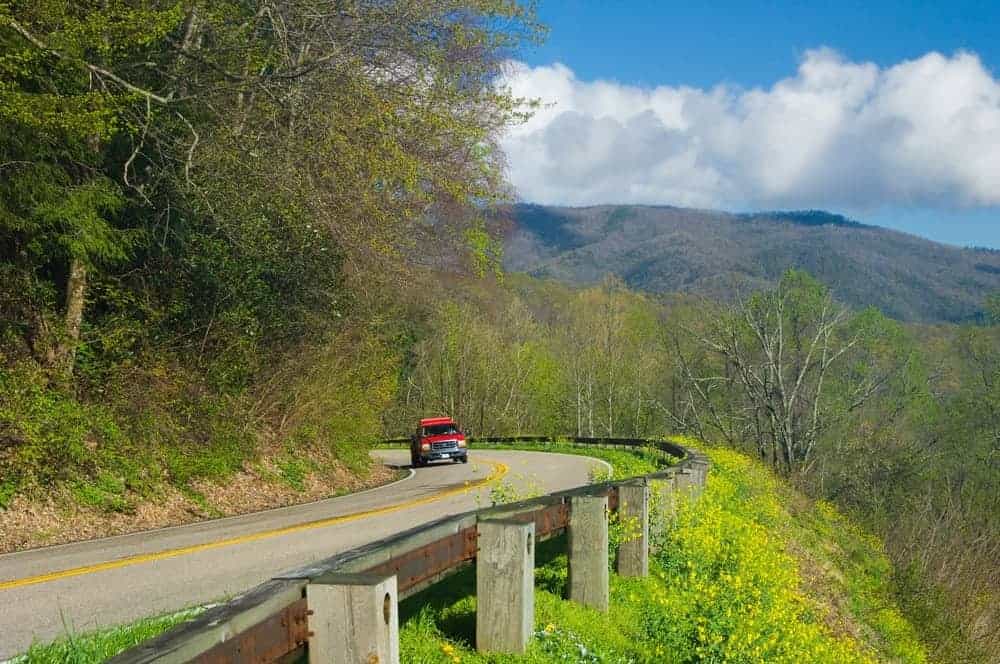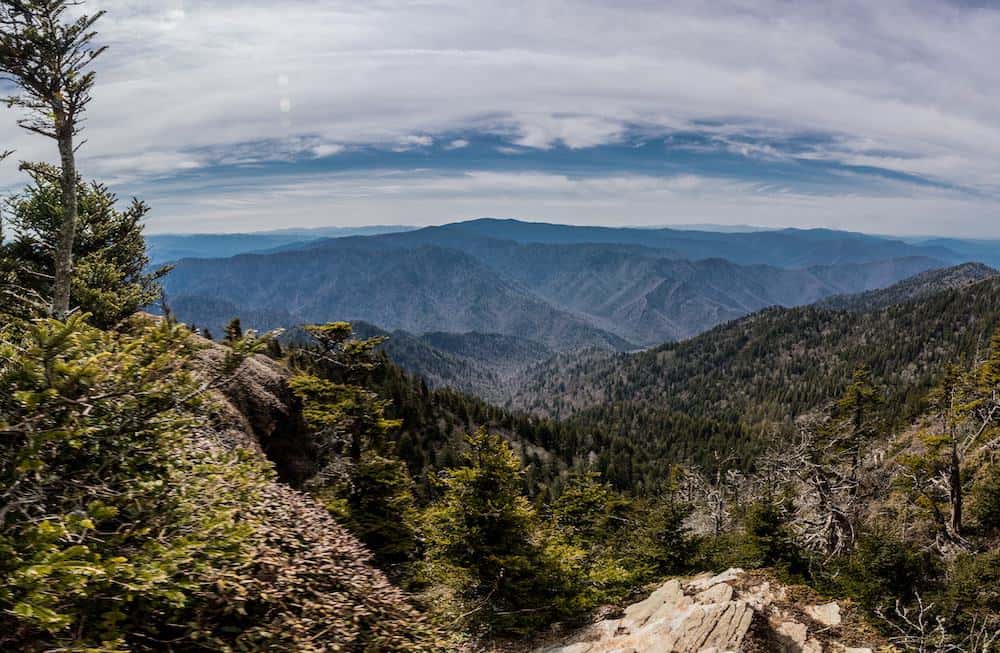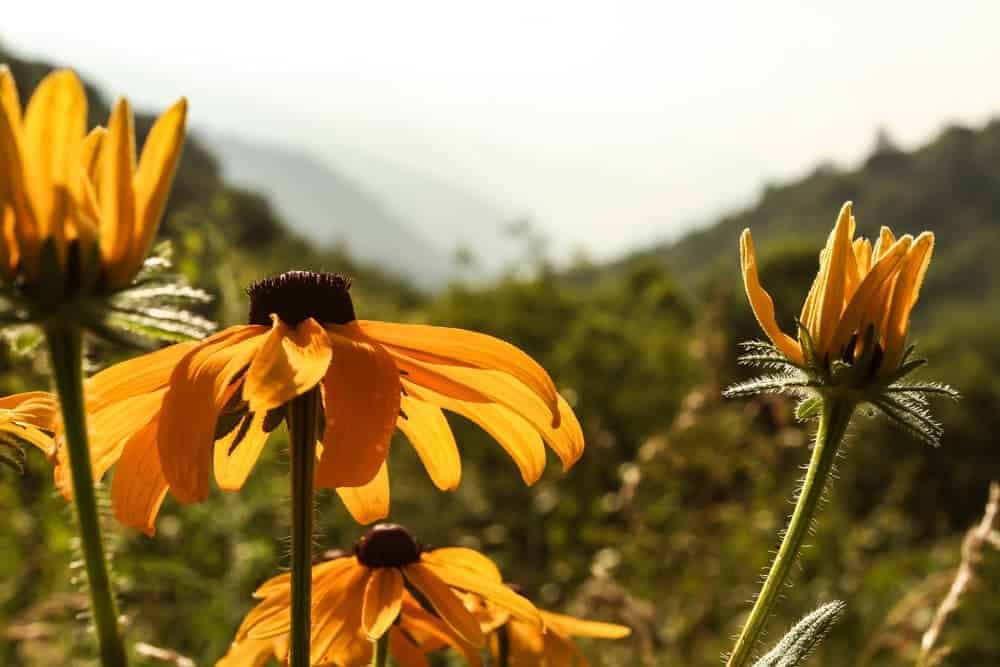
Discover the Breathtaking Blooms of the Smoky Mountain Wildflowers
April 6, 2015
With over 1,500 types of flowering plants that grow in the Great Smoky Mountains National Park year round – that’s more than in any other national park in the country! – Southern Appalachia is alive with colorful blooms throughout spring.That’s why we’ve assembled a list of a few Smoky Mountain wildflowers to keep an eye out for during your time in the Smokies.
| Spring Beauty | Claytonia virginica | Spring Beauty is an early spring wildflower, so you can find it through March. Look for a white or a pale pink blossom with 5 pink-striped petals. The plant is typically 3-4 inches tall with a pair of dark green oval leaves halfway up the stem. This flower can be found throughout the park. |
| Bloodroot | Sanguianaria canadensis | Bloodroot is frequently found in lower elevations of the Smokies through March. Narrow white petals surround a center of gold stamens with veiny, deep-lobed leaves. The bloom gets its name from the the orange-red sap that can be found in its roots. |
| Sharp-Lobed Hepatica | Hepatica nobilis | Sharp-lobed Hepatica is an early-blooming Smoky Mountain wildflower that is often found in mid to low elevations. It has a single flower on a hairy stalk, with a cluster dark, pointed lobed leaves. Round-lobed Gepatica (Hepatica americana) can also be found around the same time in the park. It has rounded leaf tips instead of pointed tip. |
| Foamflower | Tiarella cordifolia | Foamflower can be easily recognized by its delicate cone of white flowers on a leafless stem. The leaves resemble maple leaves on long, hairy stems. Foamflower can be found throughout the park. |
| Galax | Galax sp. | Found only in the Southern Appalachians, Galax is a tall tower of small white flowers surrounded by a base of evergreen leaves that turn copper-red in the winter. Galax can be found over a wide range of the park. |
| Bishop’s Cap | Mitella diphylla | Bishop’s Cap can be identified by it’s tiny fringed, bell-shaped flowers on the upper half of a 6-18-inch stalks with leaves at the base of the plant that resemble maple leaves. Bishop’s cap can be found after May in the mid to low elevations of the park. |
| White Trillium | Trillium graniflorum | Found in the mid to low elevations of the park, White trillium has a large bell-shaped flower, with three white leaves around a yellow center. As the flower ages, the white flowers turn pink. Blooming White Trillium can be seen from midwinter to late spring. |
| Catesby’s Trillium | Trillium catesbaei | Catesby’s trillium is an early spring wildflower that is only found in the Southern Appalachians. The flower hangs upside down from its stalk and, like White Trillium, has three white leaves that turn pink as the flower ages. The bloom can be found in mid to low elevations of the park. |
| Painted Trillium | Trillium undulatum | Painted trillium blooms from a single 8-20-inch stem with three white spade-shaped leaves with a dark red “v” on each leaf. Painted trillium is occasionally seen in the higher elevations of the park. |
| Vasey’s Trillium | Trillium vaseyi | Found April-May in mid to low elevations, Vasey’s Trillium has a three-leafed red flower with three sepals and petals. |
| Yellow Trillium | Trillium luteum | Yellow Trillium features a single yellow flower with narrow and upright petals. It has three leaves, three petals and three sepals. Yellow trillium bloom throughout April and May and can be found in the lower elevations of the park. |
| Halberd-Leaved Violets | Viola hasata | Halberd-Leaved Violet can be easily identified by its leaves that resemble arrowheads in shape. It has small yellow flowers clustered towards the top of the stem. The bloom can be seen after late-March and can be found in the mid to low elevations of the Great Smoky Mountains National Park. |
| Trout-Lily | Erythronium umbilicatum | Named for the Cherokee belief that when the flower bloomed, it was time to fish, Trout-Lillies are commonly seen throughout the park. The spotty and blotchy leaves resemble brook trout. The bloom is six to eight inches tall and is a single, yellow hanging flower. |
| Robin’s Plantain | Erigeron pulchellus | Robin’s Plantain is similar to a daisy with narrow light outer petals and small yellow inner petals on a small, round center. Robin’s Plantain are often found in low elevations. |
| Wild Strawberry | Fragaria virginiana | Wild Strawberries flower in the spring, with fruit appearing later in the summer. This low-growing plant has small, white flowers that can be seen throughout the park. |
| Fire Pink | Silene virginica | While the word “pink” does not mean pink coloring, each of the five petals are pinked or notched at the tip. It is a red flower on a thin stem with a pair of slender, opposite leaves. Fire Pink is commonly seen throughout the park. |
| Columbine | Aquilegia canadensis | Seen in the mid to low elevations of the park, Columbines have delicate red and yellow flowers that hang down from a thin stalk. |
| Crested Dwarf Iris | Iris cristata | Crested Dwarf Iris has three blue-purple above three unique yellow-crested sepals. It’s typically found in the mid to low elevations of the park. |
| Wild Geranium | Geranium maculatum | Found in the mid to low elevations of the park, Wild Geranium has five petals on each blossom that stand 12 to 18 inches and are vibrant pink and purple. |
| White Fringed Phacelia | Phacelia fimbriata | White Fringed Phacelia is often found in mid to high elevations of the park over large areas that resemble patches snow. Each individual flower has five white petals that resemble a cup-shaped wildflower. The petals turn purple over time. |
| Purple Phacelia | Phacelia bipinnatifida | Purple Phacelia is the tallest phacelia in the park and has purple-blue flowers on hairy stems. It has leaves that are divided into segments and then lobed. Purple phacelia is occasionally seen in mid to low elevations of the park. |
| Showy Orchis | Gelaris spectabilis | Showy Orchis are usually have two long and egg-shaped base leaves with the flowering stalk itself having no leaves. Each flower has a pink or lilac hood with a white lip. Showy orchis can be seen in the mid to low elevations. |
| Dutchman’s Britches | Dicentra cucullaria | Dutchman’s Britches can be found throughout the park and resemble a pair of pantaloons hanging on the line to dry. It is a white flower on a leafless stalk that hangs over split leaves. |
| Squirrel corn | Dicentra canadensis | Squirrel Corn has white flowers, small yellow tubers and complex leaves. It can be found throughout the park. |
| Bleeding Heart | Dicentra eximia | Bleeding Heart is the pink version of squirrel corn (Dicentra canadensis) It has four pink, heart-shaped petals over a cluster of delicate base leaves. It can be found occasionally in the mid to low elevations. |
| Blue Phlox | Phlox divaricate | Blue Phlox can be found occasionally in mid to low elevations. It is a blue or purple flower that has five petals that erupt from a narrow tube. |
| Thyme-Leaved Bluets | Houstonia serpyllifolia | Thyme-leaved Bluets are a late spring wildflower that can be seen throughout the park. They are identified by a small flower with a center yellow spot surrounded by four blue petals. Thyme-leaved Bluets are typically found in groups. |
| Jack-in-the-Pulpi | Arisaema triphyllum | Jack-in-the-Pulpit has a “Jack” appearing upright in his pulpit with a cluster of tiny flowers at the base. A portion of the flowers is green or dark purple and curves over, forming a canopy in the pulpit. |
| Wild Ginger | Asarum canadense | Wild ginger has heart-shaped leaves that conceal a small, three-leafed brown flower. It can be found throughout the mid to low elevations of the park. |
| Flame Azalea | Rhododendron calendulaceum | This flowering shrub can be found in bloom during June and July at higher elevations. Its leaves and red and yellow flowers appear towards to tip of the branch. |
Not sure where to start? There a several spring hikes in the Smokies known for their concentration of blooms. Here’s a few to get you started of your Smoky Mountain wildflower tour:
- Gregory Ridge Trail
Good wildflower viewing available for the first two miles of this trail. - Kanati Fork Trail
The first two miles of this trail offer great wildflower viewing opportunities in early spring. - Schoolhouse Gap Trail
A wide range of spring and summer flowers can be viewed on this trail, including some unusual species. - Little River Trail
This trail provides good wildflower viewing from mid-March through April. - Middle Prong Trail
Flowers as well as waterfalls are featured on this trail. In the first two miles you may see foamflower, toothwort, violets, wood sorrel and trilliums. - Cove Hardwood Self-guiding Nature Trail
This 0.75-mile loop trail offers some of the best spring wildflower viewing in the park. - Porters Creek Trail
From late March through April, the first 1.5 miles of this trail often has spectacular wildflowers. - Appalachian Trail
The 2-mile section between Newfound Gap and Road Prong Trail has good flower viewing from mid-April through May.
